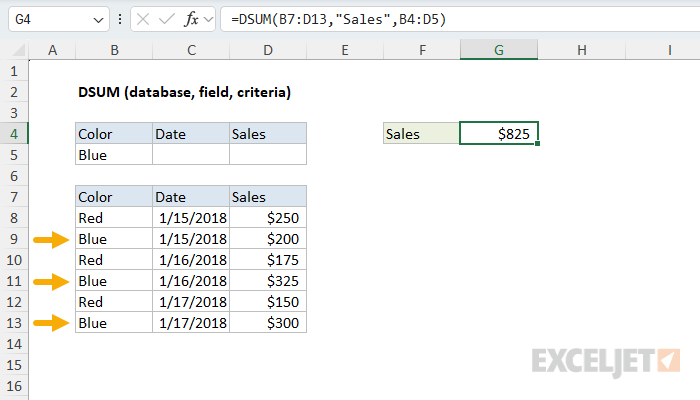Purpose
Return value
Syntax
=DSUM(database,field,criteria)- database - Database range including headers.
- field - Field name or index to count.
- criteria - Criteria range including headers.
Using the DSUM function
The Excel DSUM function calculates a sum of values in a set of records that match criteria. The values to sum are extracted from a given field in the database, specified as an argument. The database argument is a range of cells that includes field headers. The field is the name or index of the field to query, and the criteria is a range of cells with headers that match those in database. Note that field can be specified with a name or index. Using the example above, you can get the sum of all "Blue" sales with either of the formulas below:
=DSUM(B7:D13,"Sales",B4:D5) // field by name
=DSUM(B7:D13,3,B4:D5) // field by index
Criteria options
The criteria can include a variety of expressions, including some wildcards. The table below shows some examples:
| Criteria | Behavior |
|---|---|
| Red | Match "red" or "RED" |
| Re* | Begins with "re" |
| 10 | Equal to 10 |
| >10 | Greater than 10 |
| <> | Not blank |
| <>100 | Not 100 |
| >12/19/2017 | Greater than Dec 19, 2017 |
Note: support for wildcards is not as extensive as with other functions like COUNTIFS, SUMIFS, MATCH, etc. For example, the pattern "???" will match strings with exactly 3 characters in more modern functions, but not in the database functions. If you are using wildcards, test carefully.
Multi-row criteria
The criteria range for DSUM can include more than one row below the headers. When the criteria range includes more than one row, each row is joined with OR logic, and the expressions inside a given criteria row are joined with AND logic.
Notes
- DSUM supports wildcards in criteria
- Criteria can include more than one row (as explained above)
- The field argument can be supplied as a name in double quotes ("") or as a number representing the field index.
- The database and criteria ranges must include matching headers.












